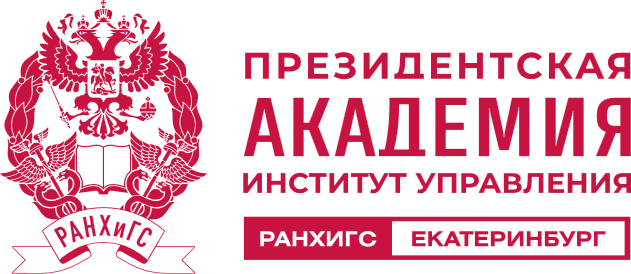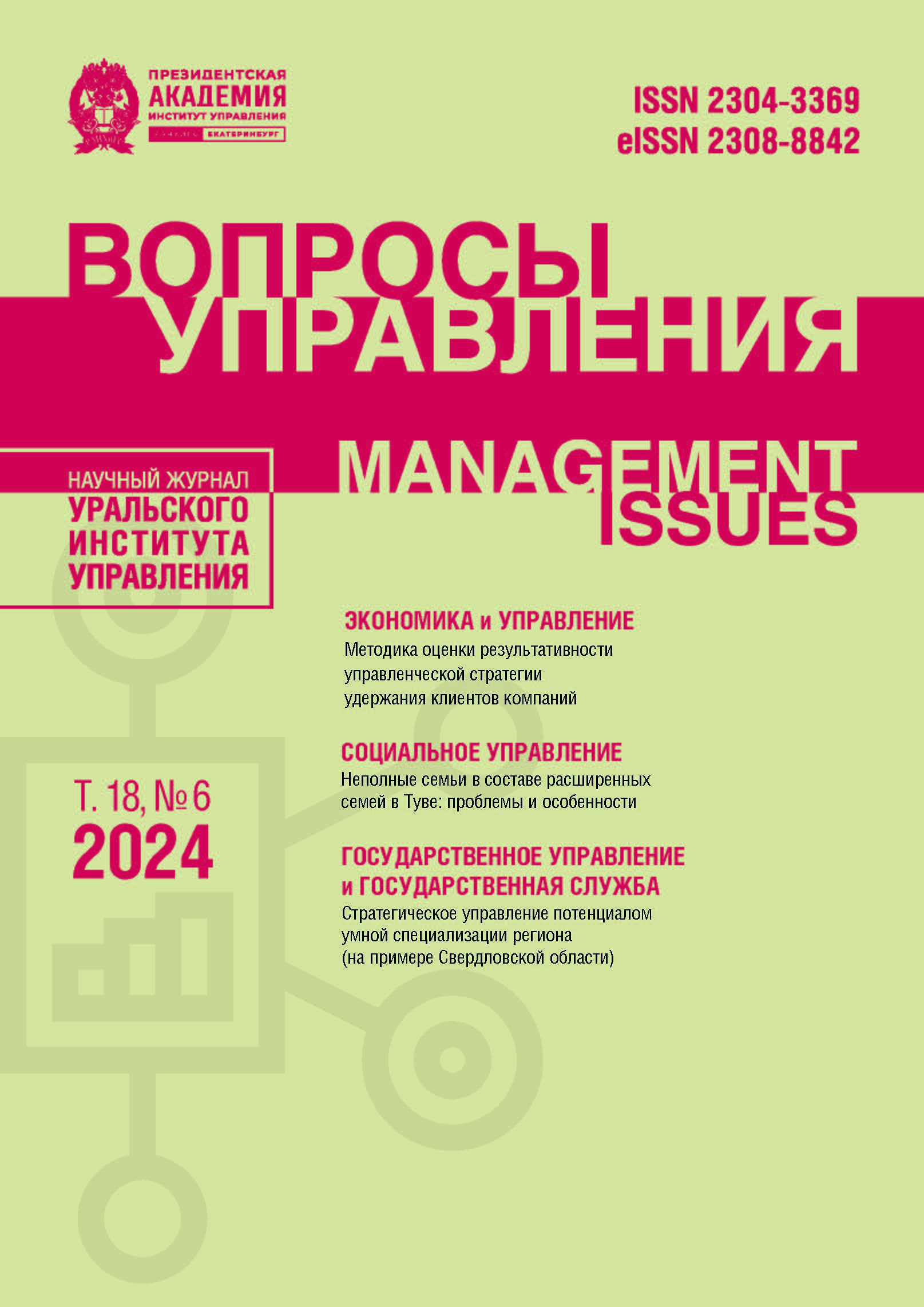Single-parent families as part in multi-generational extended families in Tuva
EDN BPVENF
DOI:
https://doi.org/10.22394/n88h5576Abstract
Introduction. In the Republic of Tuva, there is an increase in the number of single–parent families with simple
and complex multi-generational composition. There is an increase in the number of single-parent families with nuclear
and complex multi-generational composition in the Republic of Tuva. The author has set a goal to investigate
single-parent families living in multigenerational families and to analyze kinship assistance to single mothers using
sociological methods and drafting recommendations for the regional concept of family policy.
Materials and methods. The article relies on a sociological research materials held using qualitative methods
aimed at studying the social practices of women who head single-parent families in Tuva. 33 single mothers were interviewed.
Results. More than a third of single parents with children in Tuva live in households with a complex structure.
Single-parent families are often recipients of parental and kinship care. In–depth interviews with single mothers have
shown that intra-family economic flows in extended families in Tuva are predominantly downward – from the grandparents
to subsequent generations, the grandparents provide both material and instrumental assistance to singleparent
families. The assistance of the grandparents at the expense of pensions and other sources partially compensates
for the missing component in the budget of a single-parent family, which the father of the children would have to
contribute. Such a redistribution of resources improves the financial situation of single-parent families to a certain
extent, but worsens the older generation’s life quality.
Discussions and conclusions. Intergenerational downward transfers are especially relevant in conditions of a
shortage of resources in a single-parent family due to several number of children, non-employment of single mothers, lack of property in the form of housing, upkeeping students, children with disabilities, whose treatment require additional
expenses. Low incomes, high real estate values and related housing deprivation lead to increasing the number of extended multi-generational families, which include single-parent family units. Both nuclear incomplete families
and those that are part of complex extended families receive the help of their grandparents.
Keywords: single-parent families, grandparents, extended families, assistance, intergenerational transfers, child poverty, housing deprivation
References
1. Son, S., Seo, Ch. (2023) Development of Programs
for Teachers and Government Officers to Understand
Single-Parent Families. Society for the Study of
Family Policy, no. 3 (1), pр. 41-62. DOI
10.52946/jfp.2023.3.1.41.
2. Прокофьева Л. М., Корчагина И. И. Демогра-
фическая структура семей и домохозяйств в России,
её динамика по данным переписей населения // Де-
мографическое обозрение. 2023. Т. 10, № 2. С. 4– 17.
DOI 10.17323/demreview.v10i2.17763. EDN
TDYEBV.
3. Романович Н. А. Представления молодежи о
браке и семье // Социологические исследования.
2023. № 3. С. 135-140. DOI 10.31857/
S013216250021750-8. EDN PZPLRL.
4. Синельников А. Б. Социальная приемлемость
объективных и субъективных причин для развода в
современной России // Социологические исследо-
вания. 2023. № 4. С. 75–83. DOI 10.31857/
S013216250022703-6. EDN MOHTBK.
5. Алексеева А. Г. Семейно-брачные отношения
коренных народов Сибири: современный аспект //
Миссия конфессий. 2018. Т. 7. Ч. 6. С. 686–694. EDN
YZEDSH.
6. Субботин С. В. Тувинская семья и её функции.
Традиции инновации // Вестник Калмыцкого ин-
ститута гуманитарных исследований РАН. 2016.
Т. 9. № 6. (28). С. 159–171. DOI: 10.22162/2075-
7794-2016-28-6-159-171. EDN YAJJNR.
7. Гончарова Г. С., Савельев Л. Я. Семейно-брач-
ные отношения у народов Сибири: проблемы, тен-
денции, перспективы. Отв. ред. Ю. В. Попков. Но-
восибирск: Нонпарель, 2004. 288 с. EDN QCSKYT.
8. Михеева А. Р. О причинах сверхвысокой вне-
брачной рождаемости у коренных народов Сибири:
факты и гипотезы / Экономика России и Сибири:
прошлое, настоящее, будущее. Материалы научной
конференции, посвящённой 50-летнему юбилею
Института экономики и организации промышлен-
ного производства СО РАН. Отв. ред. В. В. Куле-
шов. Новосибирск: Институт экономики и органи-
зации промышленного производства СО РАН,
2008. C. 276–281. EDN RROZXX.
9. Натсак О. Д. Трансформация репродуктивной
модели тувинской семьи: историческая ретроспек-
тива и современные тенденции // Социологическая
наука и социальная практика. 2022. Т. 10, № 2.
С. 52–71. DOI: 10.19181/snsp.2022.10.2.9028. EDN
VRYUUM.
10. Ростовская Т. К., Кучмаева О. В., Василь-
ева Е. Н. Институт многопоколенной семьи как ре-
зерв демографического развития России // ДЕ-
МИС. Демографические исследования. 2023. Т. 3, № 4. С. 59–77. DOI 10.19181/demis.2023.3.4.4. EDN
PNNQUG.
11. Безвербная И. А. Многопоколенные семьи
России и США: сравнительный обзор / Семья в со-
временном обществе, Москва, 18 мая 2018 года.
Т. 4,. № 1. Под ред. С. В. Рязанцева, Т. К.Ростовской.
Москва: Общество с ограниченной ответственно-
стью "Издательство "Экон-Информ", 2018.
С. 187–192. EDN YAUSSL.
12. Бабышев В. Ю. Влияние межпоколенных
трансфертов на рождаемость // Народонаселение.
2021. Том. 24. № 1. С. 77–89. DOI:
https://doi.org/10.19181/population.2021.24.1.8.
EDN QYJAOZ.
13. Гладникова Е. В. Обзор подходов к исследо-
ванию частных межпоколенных трансфертов //
Экономическая социология. 2009. Т. 10. № 5.
С. 93-110. DOI 10.17323/1726-3247-2009-5-93-110.
EDN OYNYQD.
14. Миронова А. А. Влияние демографических
изменений на систему частных межпоколенных
трансфертов // Демографическое обозрение. 2016.
Т. 3. №3. С. 80–99. EDN WZZJGR.
15. Денисенко М. Б., Козлов В. А. Межпоколен-
ческие счета и демографический дивиденд в России
// Демографическое обозрение. 2018. Т. 5. № 4. С.
6–35. DOI: 10.17323/demreview.v5i4.8661. EDN
VRQRGC.
16. Синявская О. В., Козлов В. А., Гудкова Т. Б.
Финансовые и инструментальные трансферты в се-
мьях пожилых респондентов в России и Эстонии:
есть ли этнокультурные различия? // Мониторинг
общественного мнения: экономические и социаль-
ные перемены. 2023. № 2 (174). С. 186—211. DOI:
https://doi.org/10.14515/monitoring.2023.2.2371.
EDN LGLHQW.
17. Барсукова С. Ю. Реципрокные взаимодей-
ствия. Сущность, функции, специфика // Социоло-
гические исследования. 2004. № 9. С. 20–29. EDN
OXBQJV.
18. Барсукова С. Ю. Нерыночные обмены между
российскими домохозяйствами: теория и практика
реципрокности. М. : ГУ ВШЭ, 2004. 50 с. EDN
QQHDDT.
19. Реутова М. Н., Реутов Е. В. Шавырина И. В.
Реципрокность в социальных отношениях:
нерыночный обмен ресурсами в современной эко-
номической системе // Вестник Белгородского гос-
ударственного технического университета им. В.Г.
Шухова. 2017. №7. С. 202–206. DOI:
10.12737/article_5940f01b71aaa2.44953122. EDN
ZDDACL.
20. Реутов Е. В., Реутова М. Н., Шавырина И. В.
Реципрокность в сетях взаимопомощи (на материа-
лах регионального исследования) // Социологиче-
ские исследования. 2019. № 3. С. 106-117. DOI:
10.31857/S013216250004283-4. EDN ZADYUX.
21. Штейнберг И. Е. Психология неэквивалент-
ных обменов в сетях социальной поддержки город-
ских и сельских семей // Вестник общественного
мнения: Данные. Анализ. Дискуссии. 2004.
№ 6 (74). С. 52–57. EDN HTMKHJ.
22. Штейнберг И. Е. Процесс институционали-
зации сетей социальной поддержки в межсемейных
и дружеских обменах // Экономическая социоло-
гия. 2009. Т. 10. №2. С. 62–75. EDN OYNYGD.
23. Ярашева А. В., Макар С. В. Региональные
жилищные проблемы населения: Дальневосточный
федеральный округ // Народонаселение. 2022. Т.
25. №3. С. 89 – 102. DOI: 10.19181/population.
2022.25.3.7. EDN GYEILJ.
24. Snyder, A.R., Mclaughlin, D. K. and Findois, J.
“Household Composition and Poverty Among Female-
Headed Households with Children: Differences
by Race and Residence”, Rural Sociology, 2006,
no. 71(4), p. 597–624. DOI:10.1526/
003601106781262007.
25. Гурко Т. А. Семейные факторы репродуктив-
ного поведения // Социологические исследования.
2023. № 12. С. 72–82. DOI: 10/31857/
S0132162500029338-4. EDN WGTVDW.
26. Синельников А. Б. Обособление поколений в
семьях как фактор снижения рождаемости // Со-
циологические исследования. 2022. № 5. С. 36–48.
DOI 10.31857/S013216250020195-7. EDN FODWFN.
27. Ростовская Т. К., Натсак О. Д. Неполная се-
мья в контексте современных демографических
концепций // Социальное пространство. 2024.
Т. 10. № 2. С. 1–11. DOI: 10.15838/sa.2024.2.42.10.
EDN UYFSNI.
1. Son, S., Seo, Ch. (2023) Development of
Programs for Teachers and Government Officers to
Understand Single-Parent Families. Society for the
Study of Family Policy, 3 (1), 41–62.
https://doi.org/10.52946/jfp.2023.3.1.41.
2. Prokofieva, L. M., Korchagina, I. I. (2023) The
demographic structure of families and households in
Russia, its dynamics according to population censuses.
Demographic Review, 10 (2), 4–17. https://doi.org/
10.17323/demreview.v10i2.17763. https://
elibrary.ru/tdyebv.
3. Romanovich, N. A. (2023) Youth and marriage: a
transformation of values. Sotsiologicheskie
Issledovaniia, 3, 135-140. https://doi.org/10.31857/
S013216250021750-8. https://elibrary.ru/pzplrl.
4. Sinelnikov, A. B. (2023) Social acceptability of
objective and subjective reasons for divorce in modern
Russia. Sotsiologicheskie Issledovaniia, (4), 75–83.
https://doi.org/10.31857/S013216250022703-6.
5. Alekseeva, A. G. (2018) Family and marriage
relations of the indigenous peoples of Siberia: a modern
aspect. Mission confessions, 7 (6), 686-694.
6. Subbotin, S. V. (2016) The tuvan family and its
functions. Traditions and innovations. Vestnik
Kalmyckogo instituta gumanitarnyh issledovanij RAN, 9,
6 (28), 159–171. https://doi.org/10.22162/2075-
7794-2016-28-6-159-171. https://elibrary.ru/yajur.
7. Goncharova, G. S., Savel'ev, L. Ja. (2004) Family
and marriage relations among the peoples of Siberia:
problems, trends, prospects. Novosibirsk, Nonparel',
288. https://elibrary.ru/qcskyt.
8. Miheeva, A. R. (2008) The causes of the ultrahigh
illegitimate birth rate among the indigenous
peoples of Siberia: facts and hypotheses. In
V. V. Kuleshov (Ed.), The economy of Russia and Siberia:
past, present, and future. Materials of the scientific
conference dedicated to the 50th anniversary of the
Institute of Economics and Industrial Production SB
RAS. Novosibirsk, Institute of Economics and
Industrial Production Organization SB RAS, 276–
281. https://elibrary.ru/rrozxx.
9. Natsak, O. D. (2022) Transformation of the
reproductive model of the tuvan family: historical
retrospective and current trends. Sociologiceskaa
nauka i socialʹnaa praktika, 10 (2), 52–71.
https://doi.org/10.19181/snsp.2022.10.2.9028.
10. Rostovskaya, T. K., Kuchmaeva, O. V.,
Vasilyeva, E. N. (2023) The institute of multigenerational
family as a reserve of demographic
development in Russia. Demis. Demographic Research,
3 (4), 59–77. https://doi.org/10.19181/demis.
2023.3.4.4. https://elibrary.ru/pnnqug.
11. Bezverbnaya, I. A. (2018) Multigeneration
family of Russia and USA: comparative review. Family
in modern society. Series: "Demography. Sociology.
Economics", 4 (1), 187–191. https://elibrary.ru/yaussl.
12. Babyshev, V. Ju. (2021) Impact of
intergenerational transfers on fertility. Population, 24
(1), 77–89. https://doi.org/10.19181/population.
2021.24.1.8. https://elibrary.ru/qyjaoz.
13. Gladnikova, E. V. (2009) A review of research
approaches to private intergenerational transfers.
Economic sociology, 10 (5), 93–110. https://doi.org/
10.17323/1726-3247-2009-5-93-110. https://
elibrary.ru/oynyqd.
14. Mironova, A. A. (2016) Influence of
demographic transformation in the system of private
intergenerational transfers. Demographic review, 3 (3),
80–99. https://elibrary.ru/wzzjgr.
15. Denisenko, M. B., Kozlov, V. A. (2018)
Generational accounts and demographic dividend in
Russia. Demographic review, 5 (4), 6–35.
https:/ / doi.org/10.17323/ demreview.v5i4.8661.
16. Sinjavskaya, O. V., Kozlov, V. A., Gudkova, T. B.
(2023) Financial and instrumental transfers in the
families of elderly respondents in Russia and Estonia:
are there any ethnocultural differences? The monitoring
of public opinion: economic and social changes journal ,
2(174), 186–211. https://doi.org/10.14515/
monitoring.2023.2.2371.
17. Barsukova, S. Ju. (2004) Reciprocal
interactions - essence, functions, specifics.
Sotsiologicheskie Issledovaniia, (9), 20–29.
18. Barsukova, S. Ju. (2004) Non-market exchanges
between Russian households : theory and practice of
reciprocity. Moscow, State University Higher School
of Economics, 50 p. https://elibrary.ru/qqhddt.
19. Reutova, M. N., Reutov, E. V. Shavyrina, I. V.
(2017) Recycle in social attitudes: nonmarket
exchange of resources in the modern economic system.
Bulletin of belgorod state technological university named
after V.G. Shukhov, (7), 202–206. https://doi.org/
10.12737/article_5940f01b71aaa2.44953122. https://
elibrary.ru/zddacl.
20. Reutov, E. V., Reutova, M. N., Shavyrina, I. V.
(2019) Reciprocity in mutual aid networks (on the
data of a regional study). Sotsiologicheskie
Issledovaniia, (3), 106–117. https://doi.org/
10.31857/S013216250004283-4. https://elibrary.ru/
zadyux.
21. Shtejnberg, I. E. (2004) Psychology of nonequivalent
exchange in the social support networks of
urban and rural families. The Russian public opinion
herald, 6 (74), 52–57. https://elibrary.ru/lglhqw.
22. Shtejnberg, I. E. (2009) Institutionalization of
support networks in the inter-family and friendly
exchanges. Economic sociology, 10 (2), 62–75.
23. Jarasheva, A. V., Makar, S. V. (2022) Regional
housing problems of the population: far eastern federal
district. Population, 25 (3), 89-102. https://doi.org/
10.19181/population.2022.25.3.7. https://
elibrary.ru/gyeilj.
24. Snyder, A.R., Mclaughlin, D. K., Findois, J.
(2006) Poverty Among Female-Headed Households
with Children: Differences by Race and Residence.
Rural Sociology, 71 (4), 597–624. https://doi.org/
10.1526/003601106781262007.
25. Gurko, T. A. (2023) Family factors of
reproductive behavior. Sotsiologicheskie Issledovaniia,
(12), 72–82. https://doi.org/10/31857/
S0132162500029338-4. https://elibrary.ru/wgtvdw.
26. Sinelnikov, A. B. (2022) Separation of
generations in families as a factor for reducing birth
rate. Sotsiologicheskie Issledovaniia, (5), 36–48.
https:/ / doi.org/10.31857/S013216250020195 -7.
27. Rostovskaya, T. K., Natsak, O. D (2024). Singleparent
family in the context of modern demographic
concepts. Social area, 10(2), 1-11.
https://doi.org/10.15838/sa.2024.2.42.10. https://
elibrary.ru/uyfsni.










